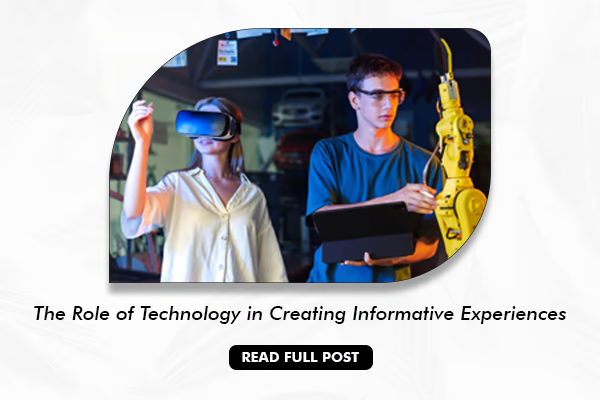Have you ever wondered how technology has transformed the way we learn about and interact with brands? From smart devices to virtual assistants, technology is now deeply embedded in our daily lives, shaping how we consume information and make decisions. In this landscape, businesses are increasingly leveraging technology to create informative experiences that captivate customers and foster long-term loyalty. But what exactly is the role of technology in crafting these experiences, and why is it so crucial?
Decoding Informative Experiences
Informative experiences are more than just educational—they provide customers with the knowledge and insights needed to make confident, informed decisions. Whether it’s understanding how a product works, exploring different service options, or getting personalized advice, these experiences help build trust between brands and customers. Trust, in turn, drives loyalty.
In the age of digital transformation, technology is the enabler that makes these informative experiences seamless, engaging, and accessible. Through technology, businesses can offer highly personalized, interactive, and real-time experiences that were previously unimaginable.
Personalization Through Data-Driven Insights
At the core of creating informative experiences is the ability to personalize content to meet the specific needs and interests of each customer. Technology plays a pivotal role here by collecting and analyzing customer data to offer tailored recommendations and insights.
For instance, many e-commerce platforms use AI-powered algorithms to analyze browsing history, past purchases, and preferences to offer personalized product recommendations. By leveraging data, businesses can anticipate customer needs and provide relevant information, making the shopping experience more efficient and enjoyable. This level of personalization not only helps customers make better decisions but also creates a stronger emotional connection with the brand, enhancing loyalty.
Interactive Tools and Immersive Technologies
Today’s customers expect more than just static content—they want to interact and engage with the information provided. This is where technologies like interactive tools, augmented reality (AR), and virtual reality (VR) come into play, transforming the way customers experience and interact with brands.
Interactive tools such as quizzes, product configurators, or virtual try-ons allow customers to actively engage with content, learning more about products or services in a hands-on way. For example, beauty and fashion brands often use AR to enable customers to “try on” makeup or clothing virtually, helping them make more informed choices without needing to visit a store. This not only enhances the customer experience but also reduces friction in the buying process.
VR, on the other hand, allows businesses to create immersive learning experiences. In industries like real estate, automotive, and travel, customers can take virtual tours of properties, cars, or vacation destinations from the comfort of their homes. These experiences provide a deeper understanding and appreciation of the product, which in turn fosters trust and increases the likelihood of purchase.
Real-Time Customer Support with AI and Chatbots
In the world of customer service, technology has revolutionized how businesses offer real-time support, enhancing the overall informative experience. AI-powered chatbots and virtual assistants provide instant responses to customer inquiries, helping them navigate complex decisions or solve problems in real-time.
For instance, if a customer is unsure about which product best suits their needs, a chatbot can guide them by asking relevant questions and providing helpful suggestions. This level of real-time assistance not only improves the customer’s experience but also reduces wait times and frustration, leading to a more positive interaction with the brand.
Moreover, chatbots can provide 24/7 support, ensuring that customers can access information whenever they need it, even outside of regular business hours. This convenience further strengthens the relationship between the brand and the customer, promoting long-term loyalty.
Seamless Integration Across Platforms
In today’s digital world, customers interact with brands across multiple channels—websites, social media, apps, and even physical stores. Technology enables businesses to create cohesive and informative experiences across all these platforms, ensuring that customers receive consistent information no matter how or where they engage with the brand.
For instance, through omnichannel strategies, brands can integrate customer data across platforms, providing a unified experience. If a customer researches a product on a website and later visits a store, the salesperson can access their online activity to offer personalized recommendations. This seamless integration not only provides customers with valuable insights but also shows them that the brand understands their journey, building trust and fostering loyalty.
Measuring Success with Analytics
Technology also enables businesses to measure the effectiveness of their informative experiences. With advanced analytics tools, businesses can track customer engagement, monitor how information is being consumed, and identify areas for improvement.
For example, companies can analyze which blog posts, tutorials, or videos are generating the most engagement or leading to conversions. These insights can help refine content strategies and ensure that the information provided continues to meet customer needs. By continuously improving the quality and relevance of informative experiences, brands can maintain a competitive edge and drive long-term customer loyalty.
Conclusion
In an era where customers are more informed and demanding than ever, the role of technology in creating informative experiences is critical. From personalized content and interactive tools to real-time support and seamless integration, technology allows businesses to offer the value-driven experiences that customers crave. By embracing these technologies, brands not only empower customers but also build the trust and loyalty needed to thrive in today’s competitive landscape.




